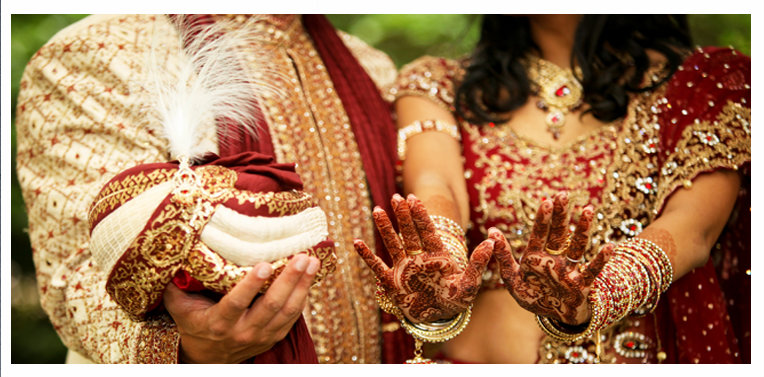The Jain community has its own rich customs and traditions that govern nuptial ceremonies. Here’s a sneak peek for you!
The Laghana Lekhan ceremony finalises the marriage decision through a ‘Laghana Lekhan pooja’ held at the bride’s home. The ‘lagna’ refers to the wedding date and time, and the ceremony concludes with a ‘lagna patrika’ (letter) which is then sent to the groom’s home with sweets.
The Lagna Patrika is then read at the groom’s home in a ‘Lagna Patrika Vachan’ (reading of the ‘Lagna Patrika’). It is usually held on the day of the engagement, but can also be held on other auspicious occasions.
The Sagai ceremony, held at the groom’s house sees him dressed in traditional Jain headgear. A prayer ceremony known as the Vinayak Yantra is performed. The ceremony concludes with the bride’s brother anointing the groom with a ’tilak’ and gifting him a gold chain, a ring, clothes, coconut, sweets and cash. The groom is then presented with the lagna patrika.
The Barati ceremony is held at the bride’s home. After the baraat reaches the bride’s residence, the brother greets the groom with the application of a ‘tika’ on his forehead. The groom is then gifted a coconut, sweets, clothes and cash by the bride’s family members. The groom then applies tika to his future brother-in-law’s forehead and presents him with a coconut.
Kanyavaran, also known as Kanyapradan marks the beginning of a Jain marriage ceremony. It sees the bride’s parents (or uncle) place the ceremonial 1 Rupee and 25 paise coins along with rice on the bride’s right hand and she is then handed over to the groom. The bride’s father formally proclaims the marriage to the assembled guests. This is followed by the chanting of mantras by a priest.
This ceremony is followed by the Granthi Bandhan. A married woman of the family ties the groom’s shawl to the bride’s pallu. Mantras are recited and the ceremony is followed by the ‘phere’, the most important ceremony for an Indian marriage.
The ‘phere’ in a Jain wedding are four rounds around the sacred fire. The first round sees the bride lead, and then the couple take lead alternately for the next three rounds around the (sacred fire). This is accompanied by the recitation of the Mahaveerakshak stoot.
The ‘phere’ is followed by the havan, which sees chanting of Peethika, Atha Gathu, Atha Nistarak, Atha Surendra, Atha Parmarajadi and Atha Paramesthi mantras, along with sacred offerings. This is concluded by chanting of the ‘Shanti mantra’ 9 times.
While the Phere are going on, the ladies sing the ‘Mangal geet’. The Phere are followed by the couple taking seven vows, and then the bride being seated on the groom’s left hand side. She is now the ‘vamangi’, which symbolizes having become the groom’s better half.
Finally, the groom and bride exchange garlands and the ceremony is concluded with the Shantipaath and Visarjan.



Facebook comments: ManaHotels